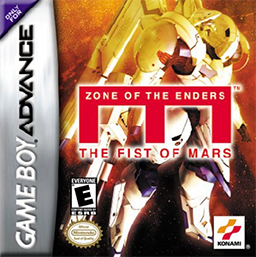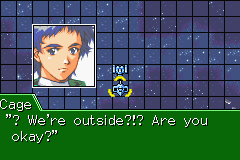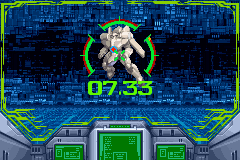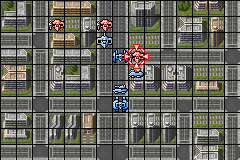There are MECHA games and then there are mecha GAMES. While the genre of giant robots is one that has been expanded upon and “reinvented” a hundred times over, every now and then one comes along that is less a variant on “blow stuff up as fast as you can” and more a “let’s look at WHY the giant robots are blowing stuff up.” Zone of the Enders: The Fist of Mars is one such game, that came and went almost a decade ago with few taking note. But for those who did, it was a gem of an experience worth repeating, and repeating often.
 Zone of the Enders started on the PS2 with a game that looked and felt like something out of the “Gundam” franchise. A boy living in a space colony suddenly finds his way of life under attack from terrorists or the military or whatever. His only hope of survival is to jump inside a giant mecha and fly off to protect his friends and fight the invaders, which he does with panache and flair. The Playstation game and its sequel were formulaic, and at times predictable, single player action games with a few RPG elements and a lot of open-ended exploring that served as wonderful eye candy, and not much else. But around the same time, Nintendo put out a version of the game, a prequel or sequel, not sure which, that gave a lot more thought to story and characters, mostly owing to the limitations of the Gameboy Advance and managed to mix in a good system of gameplay to boot.
Zone of the Enders started on the PS2 with a game that looked and felt like something out of the “Gundam” franchise. A boy living in a space colony suddenly finds his way of life under attack from terrorists or the military or whatever. His only hope of survival is to jump inside a giant mecha and fly off to protect his friends and fight the invaders, which he does with panache and flair. The Playstation game and its sequel were formulaic, and at times predictable, single player action games with a few RPG elements and a lot of open-ended exploring that served as wonderful eye candy, and not much else. But around the same time, Nintendo put out a version of the game, a prequel or sequel, not sure which, that gave a lot more thought to story and characters, mostly owing to the limitations of the Gameboy Advance and managed to mix in a good system of gameplay to boot.
Fist of Mars starts out with a boy, Cage Midwell, a worker on a cargo ship, discovering a girl sneaking into the hold of his shuttle. Soon after, a mysterious “Orbital Black Frame” attacks his ship, and he is forced to pilot a strange suit he finds within the hold. Jumping on board the “frame,” as they are called, he is quickly thrown into a battle for his life, needing to protect both himself and the strange, amnesiac girl. Captured and accused of sabotage, he is rescued by, and falls in league with, a group of activists known as “Born in Space,” seeking to liberate the colonies on Mars from Earthbound military oppression, and the boy fights alongside for the sake of his fellows, and a blue-haired girl named Myona who is being used by the regime. The story plays itself out over 26 stages, with new characters bringing new information, and the boy slowly becoming a man in the process.
 The game is equal parts play novel and tactical RPG. Stages open with often long scenes of dialogue between Cage and those around him, where they discuss politics, economics, morality, revolution and human nature. While this might seem to drag the game down, the end result is anything but, as the characters all gain solid development and insight, rather than just being “random pilot 1, 2 and 3.” Play then proceeds to the mission phase, where the frames taking part are dropped onto a squared field, and must maneuver and do battle with opposing forces. Like a tactical RPG, the field is wide open, and frames can move a preset allotment of spaces until they are adjacent to, or in range of, an enemy frame. Then combat begins, and this is where the gameplay shines.
The game is equal parts play novel and tactical RPG. Stages open with often long scenes of dialogue between Cage and those around him, where they discuss politics, economics, morality, revolution and human nature. While this might seem to drag the game down, the end result is anything but, as the characters all gain solid development and insight, rather than just being “random pilot 1, 2 and 3.” Play then proceeds to the mission phase, where the frames taking part are dropped onto a squared field, and must maneuver and do battle with opposing forces. Like a tactical RPG, the field is wide open, and frames can move a preset allotment of spaces until they are adjacent to, or in range of, an enemy frame. Then combat begins, and this is where the gameplay shines.

While there is an option for a more “traditional” attack that is based entirely on numbers and coding, the player is also given the chance to take part in a more “active time” system where the enemy suit is depicted in a “readout display” and the player either tries to hit it with a targeting crosshair (bonus damage for critical areas) or tries to avoid being hit. For players with good reflexes and patience, this allows for entire combats to end quickly from critical hits, with minimal damage taken due to expert dodging. In fact, it is entirely possible to complete the game without EVER BEING HIT, thereby allowing for more interesting customization. The game’s designers seemed to put so much effort into this unique style of gameplay that it’s actually more advantageous to use it pretty much throughout the game, and its so simple that even the most lacking of players can eventually get the hang of it, so there really is no reason to use the “traditional” system, which itself puts the player at a disadvantage.

Suits gain levels as they defeat other frames, and with each level they gain bonus points that can be spent on weapons, armor and “hull points” for future battles. Particular attention needs to be payed to distribution of said points, because grinding is almost non-existent during the mission-based stories, and a bad point setup could make the game very difficult to complete. And as previously mentioned, a good pilot might not need as much spent in armor as another, thereby varying the game even more. Indeed, Fist of Mars is one of the most customizable games I’ve ever played, allowing a degree of freedom in suit development rarely, if ever, encountered in other mecha-based games.
Zone of the Enders came and went, as I previously stated, with little fanfare in this country. And most people who did play it, remember the action-oriented Playstation incarnation. But for those looking for a solid mecha story with even more RPG elements, Fist of Mars is an excellent choice. It might be a bit harder to find now that the GBA has ridden off into the sunset, but it is well worth the effort to track down and experience.

